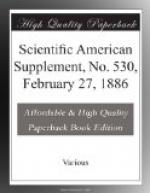The apparatus as thus represented does not at first sight appear unduly complicated. But in order to render it adjustable, so that hyperbolas of varying eccentricities and on different scales may be drawn with it, several parts not here shown must be added. A frame must be provided, in which to arrange supports for the pivots at F and F’, and these supports connected by a right and left handed screw, or equivalent means of altering the distance between the foci; the crank CI and the socket F’G must be of variable length, and these in each case would require to be carefully adjusted. So that, as we stated in the beginning, it is questionable whether a draughtsman of ordinary skill could draw the curve any more readily by the aid of such a piece of mechanism than he could without it; but it may claim a passing notice as a novel device, and the first one, we believe, for describing the hyperbola by a combination of rigid parts.
* * * * *
EXPERIMENTS WITH FIBERS.
By Dr. THOMAS TAYLOR.
As Microscopist of the United States Department of Agriculture, I am frequently called upon to make investigations as to the character of textile fibers and fabrics, not only for the public generally, but also for several departments of the Government.
Textile fibers are presented both in the raw and as articles of manufacture. In the latter case they may have been dyed, stained, or painted. It is obvious that under these conditions the fibers should be subjected to chemical reaction to bring them as nearly as possible to their normal condition.
Considering how well the structures of the common textile fibers of commerce—cotton, flax, ramie, hemp, jute, Manila hemp, silk, and wool—have been investigated and minutely described by able and exact microscopists, I will in this paper confine myself chiefly to such experiments as I have personally made with textile fibers, treating them with chemical agents while under the objective.
While I am aware that this method is not wholly new, I am satisfied that comparatively little work has been done in this direction, and that a wide field is still open for future research.
As microscopists, we have to fortify ourselves in every way that will sustain, by truthful work, the value of the microscope as a means of research, sometimes conducting our experiments under the most trying circumstances. Fibers may be so treated by experts as to make it difficult to determine how their changed appearance has been effected, and it may happen in this age of experiment and of fraud that important decisions in commercial transactions and in criminal cases may depend on our observations.




